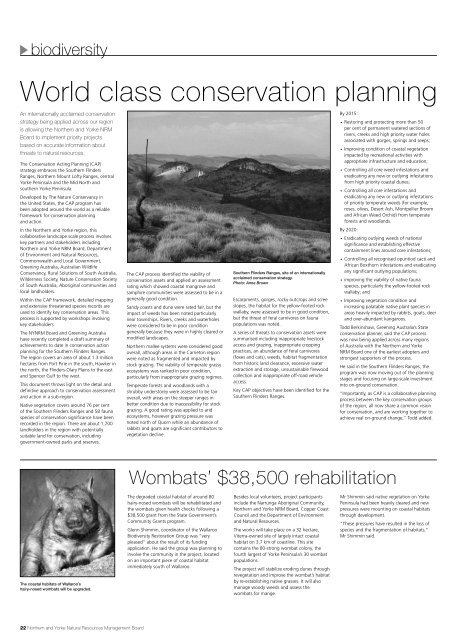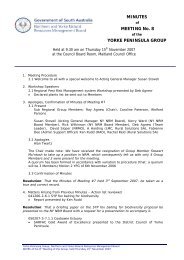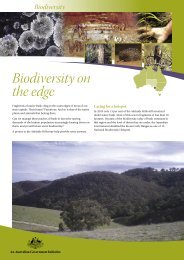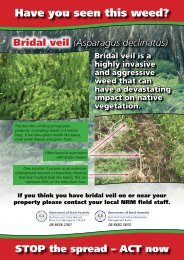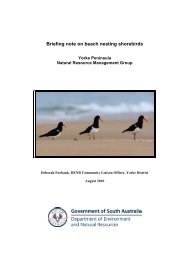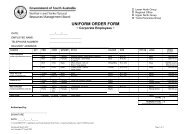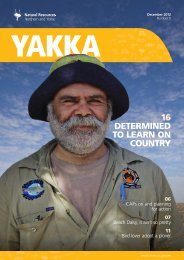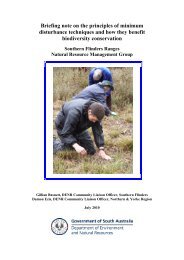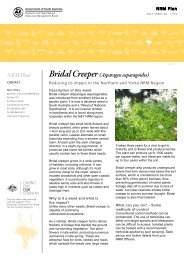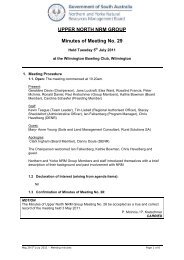Caring for country - Northern and Yorke Natural Resources ...
Caring for country - Northern and Yorke Natural Resources ...
Caring for country - Northern and Yorke Natural Resources ...
Create successful ePaper yourself
Turn your PDF publications into a flip-book with our unique Google optimized e-Paper software.
4biodiversity<br />
World class conservation planning<br />
An internationally acclaimed conservation<br />
strategy being applied across our region<br />
is allowing the <strong>Northern</strong> <strong>and</strong> <strong>Yorke</strong> NRM<br />
Board to implement priority projects<br />
based on accurate in<strong>for</strong>mation about<br />
threats to natural resources.<br />
The Conservation Acting Planning (CAP)<br />
strategy embraces the Southern Flinders<br />
Ranges, <strong>Northern</strong> Mount Lofty Ranges, central<br />
<strong>Yorke</strong> Peninsula <strong>and</strong> the Mid North <strong>and</strong><br />
southern <strong>Yorke</strong> Peninsula.<br />
Developed by The Nature Conservancy in<br />
the United States, the CAP program has<br />
been adopted around the world as a reliable<br />
framework <strong>for</strong> conservation planning<br />
<strong>and</strong> action.<br />
In the <strong>Northern</strong> <strong>and</strong> <strong>Yorke</strong> region, this<br />
collaborative l<strong>and</strong>scape scale process involves<br />
key partners <strong>and</strong> stakeholders including<br />
<strong>Northern</strong> <strong>and</strong> <strong>Yorke</strong> NRM Board, Department<br />
of Environment <strong>and</strong> <strong>Natural</strong> <strong>Resources</strong>,<br />
Commonwealth <strong>and</strong> Local Government,<br />
Greening Australia, Australian Wildlife<br />
Conservancy, Rural Solutions of South Australia,<br />
Wilderness Society, Nature Conservation Society<br />
of South Australia, Aboriginal communities <strong>and</strong><br />
local l<strong>and</strong>holders.<br />
Within the CAP framework, detailed mapping<br />
<strong>and</strong> extensive threatened species records are<br />
used to identify key conservation areas. This<br />
process is supported by workshops involving<br />
key stakeholders.<br />
The NYNRM Board <strong>and</strong> Greening Australia<br />
have recently completed a draft summary of<br />
achievements to date in conservation action<br />
planning <strong>for</strong> the Southern Flinders Ranges.<br />
The region covers an area of about 1.3 million<br />
hectares from Port Pirie in the south, Hawker in<br />
the north, the Flinders-Olary Plains to the east<br />
<strong>and</strong> Spencer Gulf to the west.<br />
This document throws light on the detail <strong>and</strong><br />
definitive approach to conservation assessment<br />
<strong>and</strong> action in a sub-region.<br />
Native vegetation covers around 76 per cent<br />
of the Southern Flinders Ranges <strong>and</strong> 58 fauna<br />
species of conservation significance have been<br />
recorded in the region. There are about 1,700<br />
l<strong>and</strong>holders in the region with potentially<br />
suitable l<strong>and</strong> <strong>for</strong> conservation, including<br />
government-owned parks <strong>and</strong> reserves.<br />
By 2015:<br />
• Restoring <strong>and</strong> protecting more than 50<br />
per cent of permanent watered sections of<br />
rivers, creeks <strong>and</strong> high priority water holes<br />
associated with gorges, springs <strong>and</strong> seeps;<br />
• Improving condition of coastal vegetation<br />
impacted by recreational activities with<br />
appropriate infrastructure <strong>and</strong> education;<br />
• Controlling all core weed infestations <strong>and</strong><br />
eradicating any new or outlying infestations<br />
from high priority coastal dunes;<br />
• Controlling all core infestations <strong>and</strong><br />
eradicating any new or outlying infestations<br />
of priority temperate weeds (<strong>for</strong> example,<br />
roses, olives, Desert Ash, Montpellier Broom<br />
<strong>and</strong> African Weed Orchid) from temperate<br />
<strong>for</strong>ests <strong>and</strong> woodl<strong>and</strong>s.<br />
The CAP process identified the viability of<br />
conservation assets <strong>and</strong> applied an assessment<br />
rating which showed coastal mangrove <strong>and</strong><br />
samphire communities were assessed to be in a<br />
generally good condition.<br />
S<strong>and</strong>y coasts <strong>and</strong> dune were rated fair, but the<br />
impact of weeds has been noted particularly<br />
near townships. Rivers, creeks <strong>and</strong> waterholes<br />
were considered to be in poor condition<br />
generally because they were in highly cleared or<br />
modified l<strong>and</strong>scapes.<br />
<strong>Northern</strong> mallee systems were considered good<br />
overall, although areas in the Carrieton region<br />
were noted as fragmented <strong>and</strong> impacted by<br />
stock grazing. The viability of temperate grassy<br />
ecosystems was ranked in poor condition,<br />
particularly from inappropriate grazing regimes.<br />
Temperate <strong>for</strong>ests <strong>and</strong> woodl<strong>and</strong>s with a<br />
shrubby understorey were assessed to be fair<br />
overall, with areas on the steeper ranges in<br />
better condition due to inaccessibility <strong>for</strong> stock<br />
grazing. A good rating was applied to arid<br />
ecosystems, however grazing pressure was<br />
noted north of Quorn while an abundance of<br />
rabbits <strong>and</strong> goats are significant contributors to<br />
vegetation decline.<br />
Southern Flinders Ranges, site of an internationally<br />
acclaimed conservation strategy.<br />
Photo: Anne Brown<br />
Escarpments, gorges, rocky outcrops <strong>and</strong> scree<br />
slopes, the habitat <strong>for</strong> the yellow-footed rock<br />
wallaby, were assessed to be in good condition,<br />
but the threat of feral carnivores on fauna<br />
populations was noted.<br />
A series of threats to conservation assets were<br />
summarised including inappropriate livestock<br />
access <strong>and</strong> grazing, inappropriate cropping<br />
practices, an abundance of feral carnivores<br />
(foxes <strong>and</strong> cats), weeds, habitat fragmentation<br />
from historic l<strong>and</strong> clearance, excessive water<br />
extraction <strong>and</strong> storage, unsustainable firewood<br />
collection <strong>and</strong> inappropriate off-road vehicle<br />
access.<br />
Key CAP objectives have been identified <strong>for</strong> the<br />
Southern Flinders Ranges.<br />
By 2020:<br />
• Eradicating outlying weeds of national<br />
significance <strong>and</strong> establishing effective<br />
containment lines around core infestations;<br />
• Controlling all recognised opuntiod cacti <strong>and</strong><br />
African Boxthorn infestations <strong>and</strong> eradicating<br />
any significant outlying populations;<br />
• improving the viability of native fauna<br />
species, particularly the yellow-footed rock<br />
wallaby; <strong>and</strong><br />
• Improving vegetation condition <strong>and</strong><br />
increasing palatable native plant species in<br />
areas heavily impacted by rabbits, goats, deer<br />
<strong>and</strong> over-abundant kangaroos.<br />
Todd Berkinshaw, Greening Australia’s State<br />
conservation planner, said the CAP process<br />
was now being applied across many regions<br />
of Australia with the <strong>Northern</strong> <strong>and</strong> <strong>Yorke</strong><br />
NRM Board one of the earliest adopters <strong>and</strong><br />
strongest supporters of the process.<br />
He said in the Southern Flinders Ranges, the<br />
program was now moving out of the planning<br />
stages <strong>and</strong> focusing on large-scale investment<br />
into on-ground conservation.<br />
“Importantly, as CAP is a collaborative planning<br />
process between the key conservation groups<br />
of the region, all now share a common vision<br />
<strong>for</strong> conservation, <strong>and</strong> are working together to<br />
achieve real on-ground change,” Todd added.<br />
Wombats’ $38,500 rehabilitation<br />
The coastal habitats of Wallaroo’s<br />
hairy-nosed wombats will be upgraded.<br />
The degraded coastal habitat of around 80<br />
hairy-nosed wombats will be rehabilitated <strong>and</strong><br />
the wombats given health checks following a<br />
$38,500 grant from the State Government’s<br />
Community Grants program.<br />
Glenn Shimmin, coordinator of the Wallaroo<br />
Biodiversity Restoration Group was “very<br />
pleased” about the result of its funding<br />
application. He said the group was planning to<br />
involve the community in the project, located<br />
on an important piece of coastal habitat<br />
immediately south of Wallaroo.<br />
Besides local volunteers, project participants<br />
include the Narrunga Aboriginal Community,<br />
<strong>Northern</strong> <strong>and</strong> <strong>Yorke</strong> NRM Board, Copper Coast<br />
Council <strong>and</strong> the Department of Environment<br />
<strong>and</strong> <strong>Natural</strong> <strong>Resources</strong>.<br />
The works will take place on a 32 hectare,<br />
Viterra-owned site of largely intact coastal<br />
habitat on 3.7 km of coastline. This site<br />
contains the 80-strong wombat colony, the<br />
fourth largest of <strong>Yorke</strong> Peninsula’s 30 wombat<br />
populations.<br />
The project will stabilize eroding dunes through<br />
revegetation <strong>and</strong> improve the wombat’s habitat<br />
by re-establishing native grasses. It will also<br />
manage woody weeds <strong>and</strong> assess the<br />
wombats <strong>for</strong> mange.<br />
Mr Shimmin said native vegetation on <strong>Yorke</strong><br />
Peninsula had been heavily cleared <strong>and</strong> new<br />
pressures were mounting on coastal habitats<br />
through development.<br />
“These pressures have resulted in the loss of<br />
species <strong>and</strong> the fragmentation of habitats,”<br />
Mr Shimmin said.<br />
22 <strong>Northern</strong> <strong>and</strong> <strong>Yorke</strong> <strong>Natural</strong> <strong>Resources</strong> Management Board


